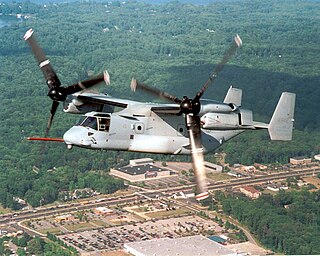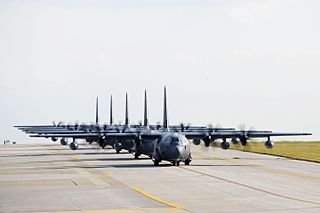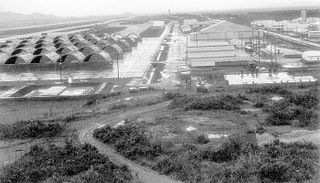
The Lockheed AC-130 gunship is a heavily armed, long-endurance, ground-attack variant of the C-130 Hercules transport, fixed-wing aircraft. It carries a wide array of ground-attack weapons that are integrated with sophisticated sensors, navigation, and fire-control systems. Unlike other modern military fixed-wing aircraft, the AC-130 relies on visual targeting. Since its large profile and low operating altitudes around 7,000 feet make it an easy target, its close air support missions are usually flown at night.

The M61 Vulcan is a hydraulically, electrically, or pneumatically driven, six-barrel, air-cooled, electrically fired Gatling-style rotary cannon which fires 20 mm × 102 mm rounds at an extremely high rate. The M61 and its derivatives have been the principal cannon armament of United States military fixed-wing aircraft for over sixty years.

A gunship is a military aircraft armed with heavy aircraft guns, primarily intended for attacking ground targets either as airstrike or as close air support.

The Douglas AC-47 was the first in a series of fixed-wing gunships developed by the United States Air Force during the Vietnam War. It was designed to provide more firepower than light and medium ground-attack aircraft in certain situations when ground forces called for close air support.

Hurlburt Field is a United States Air Force installation located in Okaloosa County, Florida, immediately west of the town of Mary Esther. It is part of the greater Eglin Air Force Base reservation and is home to Headquarters Air Force Special Operations Command (AFSOC), the 1st Special Operations Wing (1 SOW), the USAF Special Operations School (USAFSOS) and the Air Combat Command's (ACC) 505th Command and Control Wing. It was named for First Lieutenant Donald Wilson Hurlburt, who died in a crash at Eglin. The installation is nearly 6,700 acres (27 km2) and employs nearly 8,000 military personnel.

Air Force Special Operations Command (AFSOC), headquartered at Hurlburt Field, Florida, is the special operations component of the United States Air Force. An Air Force major command (MAJCOM), AFSOC is also the U.S. Air Force component command to United States Special Operations Command (USSOCOM), a unified combatant command located at MacDill Air Force Base, Florida. AFSOC provides all Air Force Special Operations Forces (SOF) for worldwide deployment and assignment to regional unified combatant commands.
The M134 Minigun is an American 7.62×51mm NATO six-barrel rotary machine gun with a high rate of fire. It features a Gatling-style rotating barrel assembly with an external power source, normally an electric motor. The "Mini" in the name is in comparison to larger-caliber designs that use a rotary barrel design, such as General Electric's earlier 20 mm M61 Vulcan, and "gun" for the use of rifle ammunition as opposed to autocannon shells.

The Fairchild C-119 Flying Boxcar was an American military transport aircraft developed from the World War II-era Fairchild C-82 Packet, designed to carry cargo, personnel, litter patients, and mechanized equipment, and to drop cargo and troops by parachute. The first C-119 made its initial flight in November 1947, and by the time production ceased in 1955, more than 1,100 had been built.

A rotary cannon, rotary autocannon, rotary gun or Gatling cannon, is any large-caliber multiple-barreled automatic firearm that uses a Gatling-type rotating barrel assembly to deliver a sustained saturational direct fire at much greater rates of fire than single-barreled autocannons of the same caliber. The loading, firing and ejection functions are performed simultaneously in different barrels as the whole assembly rotates, and the rotation also permits the barrels some time to cool. Rotary cannons, external or self-driven are used in aircraft over reciprocating bolt autocannons which are more prone to jamming in high g environments. The rotating barrels on nearly all modern Gatling-type guns are powered by an external force such as an electric motor, although internally powered gas-operated versions have also been developed.

The South Vietnam Air Force, officially the Republic of Vietnam Air Force, was the aerial branch of the Republic of Vietnam Military Forces, the official military of the Republic of Vietnam from 1955 to 1975.

The 919th Special Operations Wing is an Air Reserve Component (ARC) unit of the United States Air Force. The 919 SOW is assigned to the Tenth Air Force of the Air Force Reserve Command (AFRC) and is stationed at Duke Field, Florida.

The 18th Special Operations Test and Evaluation Squadron is an active unit of the United States Air Force, based at Hurlburt Field, Florida. The squadron performs field testing for Air Force Special Operations Command, evaluating aircraft, equipment, and tactics in realistic battlespace environments to provide decision-makers with accurate, timely, and complete assessments of mission capability. From concept development to system fielding, the unit's mission improves the survivability and combat capability of special operations forces worldwide.

The 16th Special Operations Squadron is part of the 27th Special Operations Wing at Cannon Air Force Base, New Mexico. It operates the AC-130W Stinger II aircraft in support of special operations.

The 17th Special Operations Squadron is an active unit of the United States Air Force, stationed at Cannon Air Force Base, New Mexico. The squadron operates AC-130J Ghostrider aircraft and is assigned to the 27th Special Operations Group, 27th Special Operations Wing. The squadron was previously part of the 353rd Special Operations Group at Kadena Air Base, Japan, where it operated MC-130J Commando II aircraft providing special operations capability.

Counter-insurgency aircraft or COIN aircraft are a specialized variety of military light attack aircraft, designed for counter-insurgency operations, armed reconnaissance, air escort of ground forces, and ground support against "low-intensity engagements"; usually irregular groups of insurgents armed with aircraft artillery and/or portable rockets.

The 14th Weapons Squadron is a United States Air Force unit. It is assigned to the USAF Weapons School, stationed at Hurlburt Field, Florida.

The 930th Operations Group is an inactive United States Air Force Reserve unit. It was last active with the 434th Wing, based at Grissom Air Reserve Base, Indiana. It was inactivated on 1 October 1994.

Dak Pek Camp is a former U.S. Army and Army of the Republic of Vietnam (ARVN) base northwest of Kon Tum in the Central Highlands of Vietnam.

Phù Cát Air Base (1966–1975) was a United States Air Force (USAF) and Republic of Vietnam Air Force (RVNAF) facility used during the Vietnam War (1959–1975). It is located north of the city of Qui Nhơn in southern Vietnam.
Nha Trang Airport was a French Air Force, Republic of Vietnam Air Force (RVNAF), United States Air Force (USAF) and Vietnam People's Air Force (VPAF) (Khong Quan Nhan Dan Viet Nam) military airfield used during the Vietnam War. It is located on the southern edge of Nha Trang in Khánh Hòa Province.

























